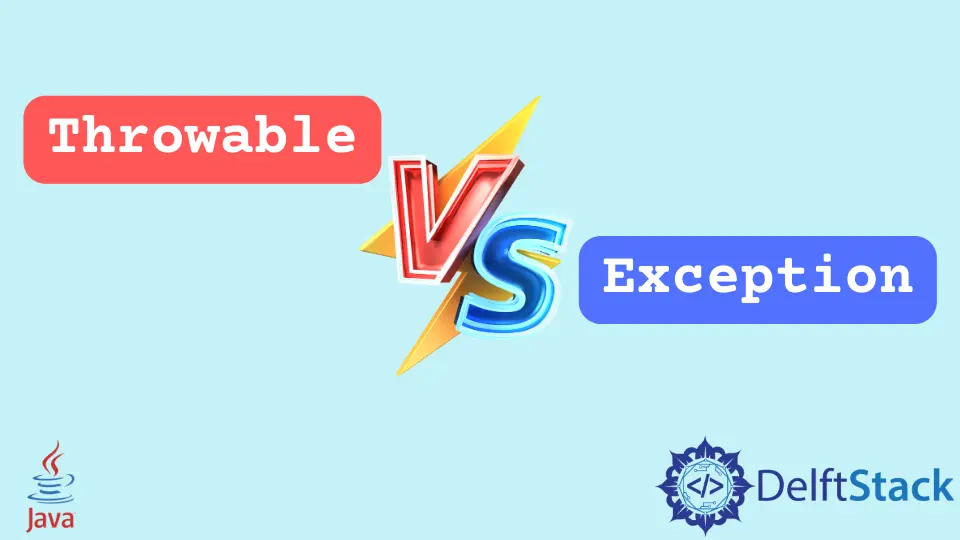Java Throwable VS Exception Class
-
Introduction to
ThrowableClass in Java -
Introduction to
ExceptionClass in Java -
Which Class Should We Use,
ThrowableorException

This article will teach us when to use the Throwable and Exception classes in Java. Both classes have their constructors and methods to handle errors and exceptions.
First, we will see the introduction of Throwable and Exception of both classes, and after that, we will learn the difference between both.
Introduction to Throwable Class in Java
In the hierarchy of the java.lang classes, the Throwable class is the parent or superclass of the Error and Exception classes. It means the Error and Exception are inherited by the Throwable class in Java.
It concludes that the Throwable class can catch all the errors and exceptions produced by the Java Virtual Machine, either stack trace errors or compile or run time exceptions.
Furthermore, the Throwable class implements the Serializable interface in the java.lang library where it is defined.
Users can see the definition of the Throwable class below.
public class Throwable extends Object implements Serializable
In the above class definition, users can see that the Throwable class inherits the Object class and implements the Serializable interface.
Syntax of Throwable:
try {
// some code
} catch (Throwable e) {
// handle errors or exceptions
}
The Throwable class contains the overloaded constructors, which are explained below.
Constructors
Throwable() |
This constructor creates a new instance of Throwable with a default error message. |
Throwable(String errorMessage) |
This constructor creates a new instance of Throwable with an errorMessage message. |
Throwable(String errorMessage, Throwable errorCause) |
This constructor also takes the cause of the error message and creates a new instance of Throwable with errorMessage and errorCause. |
Throwable(Throwable errorCause) |
This constructor creates the new instance of Throwable with a specific cause passed as a parameter. |
Methods
Here we have explained some methods of the Throwable class.
toString() |
It returns the description of the error in string format. |
getMessage() |
It returns the error message in string format. |
getCause() |
It returns the cause of the current instance of a Throwable. |
getLocalizedMessage() |
It returns the localized description of Throwable. |
getStackTrace() |
It provides information about the stack trace. |
printStackTrace() |
It prints the current instance of Throwable. |
setStackTrace(StackTraceElement[] stackTrace) |
It allows setting the element of stack trace returned by the getStackTrace() method. |
initCause(Throwable cause) |
It allows users to initialize the cause of the current Throwable. |
Errors
The Errors class includes errors that stop the program’s execution.
StackOverflowError |
It occurs when stack or heap overflow occurs. |
AssertionError |
It happens due to assertion failure. |
VirtualMachineError |
It caches all the errors in Java Virtual Machine. |
LinkageError |
It occurs due to a Linkage problem. |
OutOfMemoryError |
It occurs due to low memory on your device or JVM running out of memory. |
Introduction to Exception Class in Java
In Java, exceptions are unwanted events that occur at runtime or compile time. The exceptions can be caught at the compile time, called the checked exceptions, and exceptions can be caught only at the run time, called the unchecked exceptions.
Syntax of Throwable:
try {
// some code
} catch (Exception e) {
// handle Exceptions only
}
Here, we have defined some types of exceptions in Java.
RuntimeException |
All classes of unchecked exceptions inherit it. |
NullPointerException |
It occurs due to a null or undefined value. |
ArithmeticException |
It occurs due to the failure of an arithmetic operation. |
ArrayIndexOutOfBoundsException |
It occurs when we try to access an array index greater than its length. |
NoSuchMethodException |
It occurs when the method is not defined. |
IOException |
It occurs due to the failure of input/output operations. |
ClassNotFoundException |
It occurs when the class is not defined. |
SQLException |
The failure of database operation is the cause of this exception. |
Programmers can also define exceptions by inheriting Java’s Exception class.
Which Class Should We Use, Throwable or Exception
When we look at the syntax of the Throwable and Exception classes, it looks similar at first sight as we are using both with the try-catch block.
The instance of the Throwable class can catch the errors and exceptions as they are a subclass of Throwable, but the instance of Exceptions can only catch the exceptions that occur in the program.
In normal Java applications, rarely, errors such as LinkageError, VirtualMachineError, OutOfMemoryError, etc., occur. Mainly exception occurs due to the user’s mistake.
So, it is a best practice to use the instance of the Exception class rather than the Throwable class.
